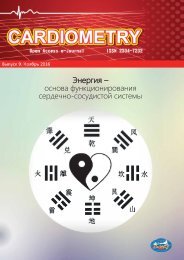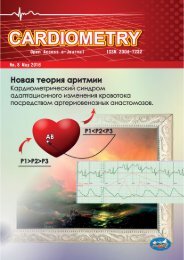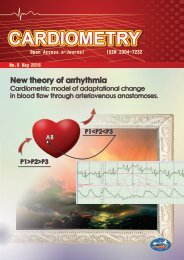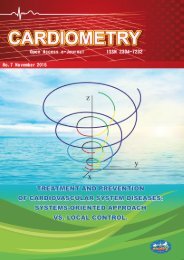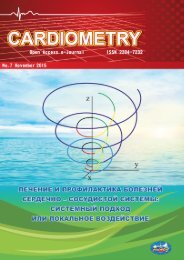Open access e-journal Cardiometry - No.9 November 2016
As might be seen, our Journal is a theme-oriented publication so that each issue offers concentrated materials targeting a certain topic. The present publication is treating the very topical problem: it is energy of the heart.
As might be seen, our Journal is a theme-oriented publication so that each issue offers concentrated materials targeting a certain topic. The present publication is treating the very topical problem: it is energy of the heart.
Create successful ePaper yourself
Turn your PDF publications into a flip-book with our unique Google optimized e-Paper software.
Figure 1. Coordinate System of the Space.<br />
The center of the System may be any point<br />
of the Space, but if the point is selected it<br />
should be taken for all further calculation to<br />
save the continuity of the data<br />
Figure 2. The set of points on the trajectory<br />
is the Minkowski’s Space. Possibly the Minkowski’s<br />
Space was introduced to hide the<br />
common sense<br />
(I Ching). That infinitude movement<br />
represents the Energy itself: the force<br />
of countless particles of the Ether<br />
has no restrictions in the Universe<br />
(against any force there is always a<br />
more powerful force available). However,<br />
each particle of the Ether has<br />
equal and permanent speed in comparing<br />
with other particles. The speed<br />
of the sole particle of the Ether is a<br />
single quant of Energy in our Universe.<br />
Exactly this peculiarity of the<br />
Ether gives the opportunity to physicists<br />
to create their quantum theories.<br />
During an equal period of time, all<br />
particles in the Ether complete the<br />
same path. It means that the time has<br />
similarity to Space: on the one hand<br />
time can be estimated by measuring<br />
the traveled distance, and on the other<br />
hand the distance may be predicted<br />
by measuring the time. It is obvious<br />
that this property of Ether in Space<br />
was used by famous mathematician<br />
Hermann Minkowski to create his<br />
theory of a pseudo-Euclidean space,<br />
where the time is the fourth dimension<br />
(The Minkowski space is the<br />
base of Einstein's relativity theory).<br />
However, in the opinion of the Author<br />
of this study, no real physical processes<br />
have relations to the Minkowski's<br />
space, and it is only a tool to record a<br />
trajectory of objects in three-dimensional<br />
space with time.<br />
The Time phenomenon is a consequence<br />
of properties of the uniform<br />
motion of the Ether's particles, and<br />
therefore it is dependent on the parameter<br />
of Space. That is actually<br />
Space contains Time, and therefore<br />
the Time itself cannot play a role of<br />
an axis of a coordinate in principle. It<br />
is only value of a distance matter. For<br />
a definite size, its own local time will<br />
flow. For example, there is no practical<br />
reason to measure processes of<br />
Galactic motion by scale of life term<br />
of Drosophila fly.<br />
The second property of the Ether<br />
is a non-uniform distribution of its<br />
particles in Space. There are constantly<br />
changing sizes of the regions<br />
with high and low density of Ether's<br />
particles. Irregular distribution of the<br />
Ether in Space generates Space anisotropy<br />
(Figure 3). The theory of relativity<br />
postulating the isotropy of medium<br />
(where the speed of light is declared<br />
as a constant) has rather weak relations<br />
with true reality.<br />
The more particles are placed per<br />
unit of volume, the higher is pressure<br />
of the Ether (the number of collisions<br />
between particles increases), and the<br />
higher energy level takes place (the<br />
amount of motion also rises). Considering<br />
a Black hole from this point<br />
of view, it is such a region in Space,<br />
where many motion vectors are spontaneously<br />
directed towards a single<br />
point. When the maximum concentration<br />
of particles is achieved, the<br />
Ether's particles under the influence<br />
of the predominance of the elastic<br />
forces start moving to the regions<br />
with a low density of the particles.<br />
Ether sparseness occurs in Space, the<br />
pressure is reduced.<br />
With the time, some local micro-spaces<br />
showing more or less equal<br />
distribution of density can spontaneously<br />
form rectangular lattices of<br />
flashing nodes (the nodes have permanent<br />
regular changes in density of<br />
the Ether). This type of construction<br />
of the crystal lattice is the most natural<br />
for the three-dimensional space<br />
(significant inequality in Space will<br />
lead to other types of crystal lattices<br />
reflecting the shape of irregularity).<br />
The distance between the nodes of the<br />
rectangular lattice will depend on the<br />
average density of the Ether in a given<br />
area of Space (Figure 4).<br />
The measure of the Ether density<br />
is determined by an averaged distance<br />
between the particles at a given<br />
volume of Space. For the neighborhood<br />
of the Earth's surface, where<br />
the observation by terrestrial physics<br />
is possible, the mean range of the<br />
Ether particles before its collision<br />
with another particle is within the<br />
Planck's wave length, and it is equal<br />
to 1,616199(97)·10 −35 meter.<br />
The ongoing process of formation and<br />
decay of Black holes produces between<br />
them and the "White" holes laminar<br />
flows of the Ether. When two laminar<br />
flows are encountered, wide varieties<br />
of sizes of Descartes vortices are created.<br />
The longest-living type of the Ether<br />
vortex has the form of toroid. As an example<br />
of the toroid formation is emission<br />
of smoke by a smoker (Fig. 5).<br />
46 | <strong>Cardiometry</strong> | Issue 9. <strong>November</strong> <strong>2016</strong>



